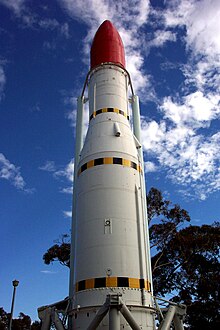Black Arrow (rocket)

Black Arrow (German black arrow ) is the name of a British three-stage rocket , which was developed from 1964 to 1971 and brought the first British satellite into space .
construction
The Black Arrow was a 13 m long three-stage rocket with a takeoff weight of 18.1 t. The first stage of the Black Arrow was 5.9 m long, had a diameter of 2 m and weighed 14.1 t. Their "Gamma-8" engine burned for 125 seconds and developed a thrust between 218 kN and 251 kN depending on the altitude. The second stage of the Black Arrow had a "Gamma-2" engine. It was 3.55 m long and 1.37 m in diameter. Their weight was 3.5 t. The "Gamma" engines of the first two stages had identical combustion chambers, but the "Gamma-2" engine of the second stage used larger thrusters. The gamma engines used the unusual fuel combination of the oxidizer 85% hydrogen peroxide and the fuel RP-1 , a type of kerosene. The highly concentrated hydrogen peroxide ignited hypergolically with the RP-1 . The third stage, mounted on a twist table, weighed 500 kg, had a diameter of 0.71 m and a length of 1.3 m. The solid propellant engine called Waxwing developed a thrust of 21 kN for 40 s.
Calls
All Black Arrow missiles were launched from Woomera , Australia. Previously, two starting places in Great Britain were also under discussion. However, South Uist was too remote and a launch from Brancaster in Norfolk would have run the risk that the burned-out first stage would have fallen onto an oil platform in the North Sea.
The first two launches were suborbital flights without a third stage. When it was first launched on June 29, 1969, the engine control failed and the rocket got out of control. When parts of the fairing broke off and the missile fell back to earth, it was blown up about a minute after launch from the ground station. In contrast, the second suborbital test flight on March 4, 1970 was a success.
At the next launch, the Waxwing apogee motor was used for the first time , which was supposed to put the Orba satellite into orbit. Orba was spherical in shape and was made from spare parts for financial reasons. One wanted to gain information about the density of the high atmosphere by tracing the orbit. When it started on September 2, 1970, the first stage worked flawlessly, but the second did not burn long enough due to a leak in the hydrogen peroxide system and switched itself off too early. The third stage worked nominally again, but could not bring the satellite up to the required speed, so that it burned up over the Gulf of Carpentaria off Northern Australia.
On October 28, 1971, the Black Arrow finally succeeded in launching the Prospero satellite . This was the first British satellite launch, making the United Kingdom the sixth state, after the Soviet Union , the United States , France , Japan and the People's Republic of China , to put a satellite into orbit on its own rocket.
End of program
Even before the fourth start, William Penney had examined the Black Arrow program for its future prospects on behalf of the British government. The need for launch vehicles for British satellites was quite small, other uses for the Black Arrow did not exist. On the other hand, not enough Black Arrows could be produced to gain enough experience. Penney therefore advised the government to end the program after the launch of the fourth rocket, leaving open the possibility of launching the reserve copy of Prospero with the already produced fifth rocket in the event of failure. Other British satellites should use launch options with US missiles.
As suggested by Penney, the Black Arrow program ended on July 29, 1971. The next British satellite, Miranda (X-4) was only launched in 1974 with a US Scout missile .
The last Black Arrow produced was not started and is now in the Science Museum in London . A full-size model is exhibited in Woomera.
Start list
| Start date ( UTC ) | Launch site | serial number | payload | height | comment |
|---|---|---|---|---|---|
| June 27, 1969 10:58 pm |
Woomera LA5B | R-0 | no | 4 km | Failure |
| March 3, 1970 9:15 pm |
R-1 | 550 km | success | ||
| September 2, 1970, 12:34 am |
R-2 | Orba (X-2), micrometeorite satellite | 550 km | Failure | |
| October 28, 1971 4:09 am |
R-3 | Prospero (X-3) | LEO | Success UK's first satellite |
literature
- Bernd Leitenberger: European launchers volume 1. From the diamond to the Ariane 4 - Europe's rocky road in the Orbit Books on Demand, Norderstedt 2009, ISBN 3837095916
Individual evidence
- ↑ a b Bernd Leitenberger: European launchers volume 1. From the diamond to the Ariane 4 - Europe's rocky road in the Orbit Books on Demand, Norderstedt 2009, ISBN 3837095916
Web links
- Bernd Leitenberger: Launchers from other nations
- Bernd Leitenberger: Black Arrow Sample chapter from the book European launchers, Volume 1. From Diamant to Ariane 4 - Europe's rocky road into orbit (PDF file; 1.55 MB)
- Black Arrow in the Encyclopedia Astronautica (English)
- Spaceuk.org: Black Arrow (English)
- Black Arrow launcher (English)


